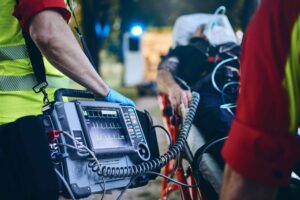BLS in Adults and Children part 8
Defibrillation considerations
Pacemakers and Internal defibrillators –
 Some patients may have pacemakers or internal defibrillators in place. They are often identifiable by a scar and hard mass present on the left side of the chest, under the clavicle. It can sometimes be positioned on the right. When placing defibrillator pads, you must try to keep their placement at least 8 cm away from the pacemaker. If, due to the bodily structure of the patient, you are unable to do this, then consider using alternative pad placement, such as anterior-posterior.
Some patients may have pacemakers or internal defibrillators in place. They are often identifiable by a scar and hard mass present on the left side of the chest, under the clavicle. It can sometimes be positioned on the right. When placing defibrillator pads, you must try to keep their placement at least 8 cm away from the pacemaker. If, due to the bodily structure of the patient, you are unable to do this, then consider using alternative pad placement, such as anterior-posterior.
Ambulances often carry magnets for managing pacemakers and internal defibrillator devices. Placing a magnet on a pacemaker will generally result in it pacing at a fixed rate of 50-100/min. Placing a magnet on an internal defibrillator will result in disabling it from shocking the patient. When looking at defibrillation, you may need to use a magnet to manage the internal device so you can view correct rhythms on a manual defibrillator.
Oxygen use and risk of explosion –
When using O2 during a cardiac arrest, high concentrations of O2 may present an explosive risk. If a secure airway circuit hasn’t been set up, move the O2 and attached BVM at least 2 meters away. If you are working in a confined space, consider the build-up of O2 in the environment and whether this will create an explosion risk with defibrillation and other fire/electrical hazards present.